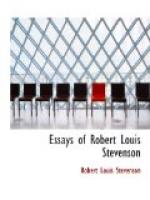NOTES
This essay first appeared in Longman’s Magazine for November 1882, Vol. I, pp. 69-79. Five years later it was published in the volume Memories and Portraits (1887), followed by an article called A Humble Remonstrance, which should really be read in connection with this essay, as it is a continuation of the same line of thought. In the eternal conflict between Romanticism and Realism, Stevenson was heart and soul with the former, and fortunately he lived long enough to see the practical effects of his own precepts and influence. When he began to write, Realism in fiction seemed to have absolute control; when he died, a tremendous reaction in favor of the historical romance had already set in, that reached its climax with the death of the century. Stevenson’s share in this Romantic revival was greater than that of any other English writer, and as an English review remarked, if it had not been for him most of the new authors would have been Howells and James young men.
This paper was written at Davos in the winter of 1881-2, and in February, writing to Henley, the author said, “I have just finished a paper, ‘A Gossip on Romance,’ in which I have tried to do, very popularly, about one-half of the matter you wanted me to try. In a way, I have found an answer to the question. But the subject was hardly fit for so chatty a paper, and it is all loose ends. If ever I do my book on the Art of Literature, I shall gather them together and be clear.” (Letters, I, 269). On Dec. 8, 1884—the same month in which A Humble Remonstrance was printed, Stevenson wrote an interesting letter to Henry James, whose views on the art of fiction were naturally contrary to those of his friend. See Letters, I, 402.
[Note 1: Like a pig for truffles. See the Epilogue to Browning’s Pacchiarotto etc., Stanza XVIII:—“Your product is—truffles, you hunt with a pig!”]
[Note 2: The Malabar coast. A part of India.]
[Note 3: Jacobite. After James II was driven from the throne in 1688, his supporters and those of his descendants were called Jacobites. Jacobus is the Latin for James.]
[Note 4: John Rann or Jerry Abershaw. John Rann I cannot find. Louis Jeremiah (or Jerry) Abershaw was a highway robber, who infested the roads near London; he was hung in 1795, when scarcely over twenty-one years old.]
[Note 5: “Great North road.” The road that runs on the east of England up to Edinburgh. Stevenson yielded to the charm that these words had for him, for he began a romance with the title, The Great North Road, which however, he never finished. It was published as a fragment in The Illustrated London News, in 1895.]
[Note 6: What will he Do with It? One of Bulwer-Lytton’s novels, published in 1858.]
[Note 7: Since traced by many obliging correspondents to the gallery of Charles Kingsley.]




